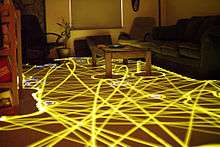Robotic vacuum cleaner
A robotic vacuum cleaner, often called a robovac, is an autonomous robotic vacuum cleaner that has intelligent programming and a limited vacuum cleaning system. Some designs use spinning brushes to reach tight corners. Others combine a number of cleaning features (mopping, UV sterilization, etc.) simultaneous to vacuuming, thus rendering the machine into more than just a robot "vacuum" cleaner.
History

The first robot cleaner to be put into production was Electrolux Trilobite by the Swedish household and professional appliances manufacturer, Electrolux. In 1996, one of Electrolux's first versions of the Trilobite vacuum was featured on the BBC's science program, Tomorrow's World.[1]
In 2001, the British technology company Dyson built and demonstrated a robot vacuum known as the DC06. However, due to its high price, it was never released to the market.[2]
In 2002, the American advanced technology company, iRobot launched the Roomba floor vacuuming robot. Initially, iRobot decided to produce 15,000 units and 10,000 more units depending on the success of the launch. The Roomba immediately became a huge consumer sensation. By the Christmas season, iRobot produced 50,000 units to meet the holiday demand. After this success, major specialty retailers as well as more than 4,000 outlets such as Target, Kohl's and Linens 'n Things began to carry the Roomba.[3]
Since 2002, new variations of robotic vacuum cleaners have appeared in the market.[4] For example, the Canadian bObsweep robotic vacuum that both mops and vacuums,[5] or the Neato Robotics XV-11 robotic vacuum, which uses laser-vision rather than the traditional ultrasound based models.[6]
In 2014, Dyson announced the release of its new robotic vacuum called Dyson 360 Eye, equipped with a 360 degree camera that is mounted on the top of the robot vacuum cleaner and is supposed to provide a better navigation than other brands. The robot vacuum was scheduled for a Japan-only release in spring 2015 with international launches to follow later in the year.[7] Moreover, Dyson announced that the 360 Eye has twice the suction of any other robot vacuum. The accuracy of this claim is doubtful however, since Dyson has been sued for similar claims on multiple occasions before. [8]
As of 2016 20% of vacuum cleaners are robots.[9]
As of 2017 23% of vacuum cleaners are robots.[10]
See also
References
- ↑ "BBC NEWS - Technology - Robot cleaner hits the shops".
- ↑ Ulanoff, Lance. "Dyson Wants to Build a Robot Vacuum that Can See".
- ↑ "How the Roomba Was Realized". 6 October 2003 – via www.bloomberg.com.
- ↑ "What Things you must pay attention when buying vacuum cleaner robot" (in German). Retrieved 2017-05-08.
- ↑ "VIDEO - bObsweep vs Roomba: Battle Of The Robots - Viewpoints Articles". 23 January 2014.
- ↑ "neato robotics frees people household chores launch - Search results from HighBeam Business".
- ↑ "Deluxe brand Dyson creates its first robot vacuum, the 360 Eye". 2014-09-04. Retrieved 2015-09-26.
- ↑ Euro-Pro Operating LLC v. Dyson Inc., 2015 U.S. Dist. LEXIS 20558; Sharkninja Operating LLC v. Dyson Inc., 2016 U.S. Dist. LEXIS 144842
- ↑ 20% of All Vacuums are Robots
- ↑ "You rest, they work. Robovac complete guide".
External links
| Wikimedia Commons has media related to Robot vacuum cleaners. |
- Info, History and Reviews of Robotic Vacuums, retrieved 2015-02-20.